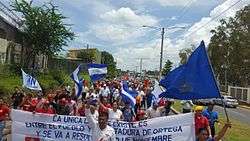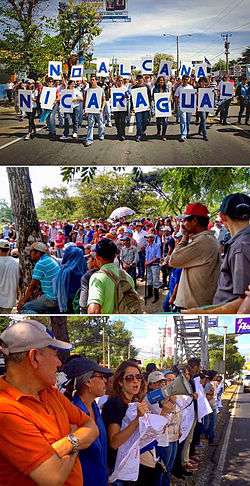2014–16 Nicaraguan protests
| 2014–16 Nicaraguan protests | |||
|---|---|---|---|
|
Top to bottom: Protesters gathered on 10 December 2014 denouncing the Nicaraguan Canal. Campesinos gathered in El Tule on 23 December 2014. Protesters demanding freedom of the press. | |||
| Date |
10 December 2014 – ongoing (1 year, 11 months, 1 week and 4 days) | ||
| Location |
| ||
| Parties to the civil conflict | |||
|
| |||
| Lead figures | |||
| |||
| Number | |||
| |||
| Casualties | |||
| Death(s) | 2 (2014)[1] | ||
| Injuries | 20+[2] (2014) | ||
| Arrested | 47[2] (2014) | ||
The 2014–16 Nicaraguan protests are a series of protests against Nicaraguan President Daniel Ortega and actions performed by his government. The protests initiated when construction began on the Nicaraguan Canal, with several hundred protesters blocking roads and clashing with police during the groundbreaking of the canal.[3] Since then, tens of thousands of Nicaraguans protested against President Ortega due to the canal and what they call a corrupt electoral system.[4][5]
Background
Steven Levitsky of Harvard University stated that, "Only under the dictatorships of the past ... were presidents reelected for life", with Levitsky further saying that while Latin America experienced democracy, citizens opposed "indefinite reelection, because of the dictatorships of the past".[6] Levitsky then noted that "In Nicaragua ... reelection is associated with the same problems of 100 years ago".[6] The Washington Post also stated in 2014 "Daniel Ortega of Nicaragua ... used the ballot box to weaken or eliminate term limits".[7]
Early in Ortega's presidency he allied with Venezuelan President Hugo Chávez and his regional block which provided $500 million in oil subsidies annually to Ortega's government.[8] Critics stated that the subsidies worked as a slush fund and helped President Ortega maintain political strength.[8] Going into the 2010s, Venezuela, President Ortega's ally, began to experience economic difficulties.[9][10][11][12] On 15 June 2013, President Ortega announced that his government was partnering with Wang Jing to construct the Nicaraguan Canal, a plan to construct a canal through Lake Nicaragua and the surrounding area that the Nicaraguan government claimed would benefit the economy of the country.[8] Sergio Ramírez, a former vice president of President Ortega, "suspected Ortega of using the canal to keep himself in office and also, possibly, to enrich himself", with Ramírez stating that "Ortega wants to make it appear that his tenure in power is indispensable in order to consummate this long-term project".[8]
According to the Business-Anti-Corruption Portal, corruption among political circles within the Nicaraguan government "impairs the functioning of state institutions and limits foreign investment", while multinational companies also "report widespread favouritism and impunity among public officials".[13] The Business Anti-Corruption Portal also notes that "[t]he protection of property rights is weak due to public authorities' failure to enforce court orders".[13] Many campesinos near the canal's path began to protest against President Ortega and the plan due to the Chinese firm's ability to expropriate their land, possibly displacing over 100,000 Nicaraguans.[4][14] Such expropriations were granted by President Ortega's government in 2013 only after three hours of debate, with the Nicaraguan government granting HKND, the developer of the canal, power to confiscate any property it needs in Nicaragua.[15] Some Nicaraguans believed that President Ortega gave up Nicaragua's sovereignty and environment to the Chinese, with one independent newspaper reminding Nicaraguans that in 2007, President Ortega stated that he would not risk Lake Nicaragua's stability "for all the gold in the world".[3]
Timeline of events
Protests began during the final days of 2014 with clashes ensuing, with campesino protesters being arrested and allegedly beaten by Nicaraguan authorities.[2] Members of the Independent Liberal Party also began protesting every Wednesday demanding electoral law reforms.[16] According to Nicaraguan sociologist Manuel Ortega Hegg, the protests against President Ortega "involve a wider range of groups, like campesinos" who were formally allied with Ortega, along with "many who are sympathetic to the government", noting that those who are demonstrating are from "beyond political parties".[15] He further states that since Nicaraguans were left out of the dialogue, that "their only recourse is to take to the streets".[15]
2014
December
On 24 December, campesinos and Nicaraguan authorities clashed, with 47 of the protesters and their leaders being arrested.[2] It was reported that the government was searching each home in the area to find those who participated in the protests.[2] On 26 December, protesters demonstrated outside of El Chipote Prison and were confronted by motorizados, Sandistas on motorcycles, with some protesters being released later that day.[2] On 30 December, 6 of the campesino leaders were released from El Chipote Prison.[2]
2015
January
In Ometepe, residents greeted a Nicaraguan government medical team with a banner that read "Traitor Ortega, no more lies", with activists in the area stating that the medical team only wanted their identification numbers so they could show that "you’re in favor of the canal".[15]
June
On 14 June, thousands of Nicaraguans protested with about 15,000 and 30,000 demonstrating in Juigalpa.[4] The protest consisted mostly of "peasants" with organizers surprised that the number of protesters was larger than the 10,000 they had anticipated.[17]
July
On 8 July, about 200 protesters in Managua demonstrated against what they called electoral rules that "favours Ortega’s Sandinista party".[5] Clashes then erupted between authorities and protesters when protesters grew close to the electoral offices, with police beating protesters and journalists, breaking one Associated Press photographer's camera lens.[5][16][18] About nine lawmakers from the Independent Liberal Party were also arrested and later released.[18] On 15 July, the weekly protest in Managua was attended by about 300 protesters, with not only the Independent Liberal Party participating but members of the Sandinista Renovation Movement, among others upset with government actions.[16] Multiple buses full of protesters destined to participate at the protest were also stopped by Nicaraguan authorities, with some individuals being temporarily detained.[16][19]
2016
According to the Economist Intelligence Unit in their August 2016, Nicaragua: Country outlook report, "management of rural protests, particularly those related to nascent plans for a transoceanic canal, have damaged his support, and complaints about a lack of accountability and transparency in government will intensify".[20]
January
The 56th protest occurred on 9 January, with hundreds of farmers gathered in La Fonseca, demanding that Law 840, the law that granted the construction of the Nicaragua Canal, be revoked. The collection of signatures representing the dissatisfaction with the canal also took place during the demonstrations.[21]
April
On 22 April, thousands of Nicaraguans protested in Managua, with Jose Chavarria, a farmers group leader, stating that protesters would continue to fight the Nicaragua Canal.[22]
June

Two United States diplomats and a professor were expelled from Nicaragua on 14 June due to their studies on the canal, with President Ortega stating, "Our government has been forced to remove two people who, being United States government officials with official passports, carried out in Nicaragua without the knowledge of or coordination with our authorities tasks that are the purview of the Nicaraguan government".[23]
On 25 June, five foreign activists were deported for alleged possession of explosives after a small fire occurred at a home that was teaching about wood stoves.[24]
The United States government then issued a travel warning to US visitors on 29 June due to the Nicaraguan government's reactions to protest, which included the deportation and expulsion of foreign visitors.[24]
References
- ↑ Plumer, Brad (26 February 2015). "The fiasco that is the Nicaragua Canal, explained". Vox. Retrieved 15 July 2015.
- 1 2 3 4 5 6 7 Rogers, Tim (27 December 2014). "Sandinistas 'bare claws' to defend Chinese canal in Nicaragua". Fusion. Retrieved 15 July 2015.
- 1 2 Lee Anderson, Jon (2 January 2015). "Breaking Ground on the Nicaragua Canal". The New Yorker. Retrieved 15 July 2015.
- 1 2 3 Wand, Alexander (14 June 2015). "Mass protests in Nicaragua as farmers claim planned canal will 'sell country to the Chinese'". The Independent. Retrieved 15 July 2015.
- 1 2 3 "Clashes erupt at Nicaragua electoral reform protests". Euronews. 9 July 2015. Retrieved 15 July 2015.
- 1 2 "Does Ecuador's leader aspire to a perpetual presidency?". The Christian Science Monitor. 11 April 2014. Retrieved 10 July 2015.
- ↑ Miroff, Nick (15 March 2014). "Ecuador's popular, powerful president Rafael Correa is a study in contradictions". The Washington Post. Retrieved 10 July 2015.
- 1 2 3 4 Lee Anderson, Jon (10 March 2014). "The Comandante's Canal". The New Yorker. Retrieved 15 July 2015.
- ↑ Siegel, Robert (25 December 2014). "For Venezuela, Drop In Global Oil Prices Could Be Catastrophic". NPR. Retrieved 4 January 2015.
- ↑ Corrales, Javier (7 March 2013). "The House That Chavez Built". Foreign Policy. Retrieved 6 February 2015.
- ↑ Gallagher, J. J. (25 March 2015). "Venezuela: Does an increase in poverty signal threat to government?". The Christian Science Monitor. Retrieved 29 March 2015.
- ↑ Corrales, Javier (7 May 2015). "Don't Blame It On the Oil". Foreign Policy. Retrieved 10 May 2015.
- 1 2 "Nicaragua Corruption Profile". Business Anti-Corruption Portal. Retrieved 14 July 2015.
- ↑ Miranda, Wilfredo (15 June 2015). "A Canal Too Far: Nicaraguan Campesinos Tell Ortega To Take His Canal And Shove It". Huffington Post. Retrieved 15 July 2015.
- 1 2 3 4 Van Note, Sara (24 March 2015). "Why the Nicaragua canal poses new challenge to Ortega's power (+video)". The Christian Science Monitor. Retrieved 15 July 2015.
- 1 2 3 4 "Oposición marcha bajo fuerte despliegue policial en Nicaragua". El Nuevo Herald. 15 July 2015. Retrieved 19 July 2015.
- ↑ "Thousands march against canal project in Nicaragua". EFE. 14 June 2015.
- 1 2 "Nicaraguan police beat protesters and harass journalists". Associated Press. 9 July 2015. Retrieved 15 July 2015.
- ↑ "Nueva protesta en Nicaragua por ley electoral". E&N. 15 July 2015. Retrieved 19 July 2015.
- ↑ "Nicaragua: Country outlook". The Economist Intelligence Unit. Retrieved 5 September 2016.
- ↑ "Renewed Protest over the Nicaragua Canal Project - Havana Times.org". Havana Times. 12 January 2016. Retrieved 5 September 2016.
- ↑ "Thousands march to protest proposed Nicaragua canal | Fox News". Fox News. 22 April 2016. Retrieved 5 September 2016.
- ↑ "Washington protests after Nicaragua expels US diplomats". The Daily Telegraph. Retrieved 5 September 2016.
- 1 2 Dyer, Zach (6 July 2016). "US alert for Nicaragua comes amid string of detentions". The Tico Times. Retrieved 5 September 2016.
